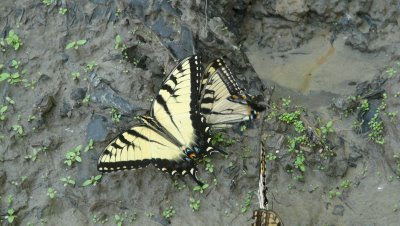
Amish buggy waits outside a restaurant in Howe, Indiana.
I'm always more interested in meeting people than seeing things. Now that we are among the Amish in Indiana I'm just in my glory. We came into the tiny town of Howe, a farming community east of Elkhart, Indiana, and we stopped at a campground out in what was once a farm field. We drove "downtown" after we were settled and there they were: two black buggies tied to a hitching post outside a Pizza Hut.
We went to the CVS pharmacy to fill a prescription and there were six buggies tied there.
The next day, Saturday, was market day and we wandered around the central part of Howe and bought the bacon and cheese bread ($1.50) made by a delightful Amish woman whose prim green dress was fastened with plain pins. Her white cap had simple ribbons to tie it down. Next to her were three men, with their beards - but no mustache. Their young boys were bored with the market and sat in chairs with their straw hats over their faces. The men were selling cabbage and cucumbers - organic, of course. We did not shoot pictures of these people because they do not believe their image should be captured.
We wandered along country roads, passing the buggies which clip-clop along in their own lane, and came to the town of Shipshewana, considered a cultural center for the Amish and their less biblically strict brothers, the Mennonites. We stopped into Yodel's meat market and it was humming with the plain people, as they are called. All the meats are wrapped in white paper and are labeled. Jo didn't like that she couldn't see the meat. So she wouldn't buy. But I bought a two-pound dollop of churned butter.
We wandered through town and visited a saddlery since this is such a horse culture. Many of the Amish still plough their fields with big Belgian horses. The saddlery was loaded with hundreds, perhaps thousands, of bits, bridles and other things equestrian. There was a great variety of saddles and blankets and boots and hats.
The Amish just don't believe in using the internal combustion engine, or electricity, or any of the millions of other modern conveniences we take for granted.
Their dolls, by the way, have no facial features. I actually see a bit of a similarity between the Amish and Muslims we have met in Malaysia and Pakistan. You'll have a hard time finding a doll in a Muslim household because they do not believe in creating likenesses of people. They did make an exception for Barbie dolls, strangely, because they simply do not believe Barbie is representative of anything human. I like that.
Back at the campground, we met up with an RV-er who retired early after a career as a repo man. For those of you outside the U.S., a repo man is a person who is hired to repossess cars, trucks and other vehicles when their owners default on their payments.
Tim told us he used to earn a six-figure income as a repo man, generally getting about $650 per vehicle on average. I asked about the dangers involved and he said he had only been approached once by a man with a gun. He said he made a point of grabbing the vehicles in the dead of night. He said he had a tow truck with an extending wheel which would pop under the towed vehicle and he'd hoist and haul in a matter of seconds. If a vehicle was in a garage, he said he'd patiently wait until the owner drove it to work. Then he'd make his move.
One story he told was of the owner of a Jaguar, a woman. She drove it to the gas station, filled it and went into the station to pay for the gas. He decided to drive it away so he left his vehicle, tried to open the door - but it was locked. The woman had left the sunroof open, though, so he jumped into the car through the roof opening. She came out of the gas station, screaming at him to stop. He showed her the paperwork and offered to drive her home or to the office. She accepted.
And so life goes.



